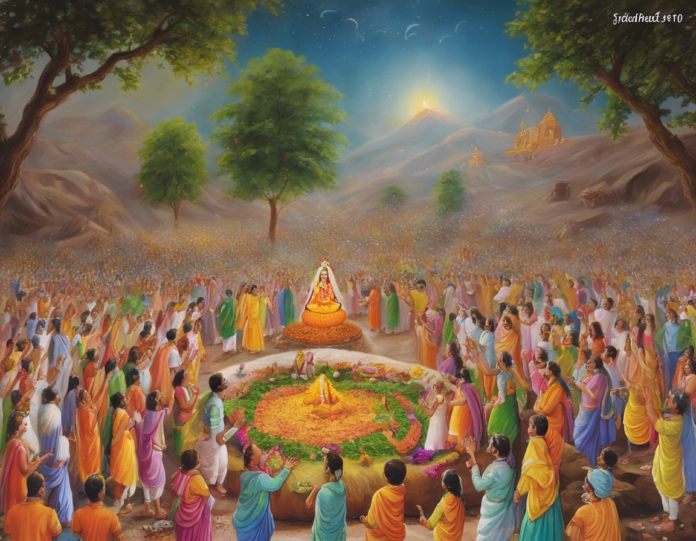Introduction
Govardhan Puja is a significant Hindu festival celebrated with fervor and enthusiasm across India, particularly in the northern states like Uttar Pradesh, Punjab, and Haryana. This auspicious day falls on the fourth day of Diwali, the festival of lights, and holds great spiritual and cultural significance in Hindu mythology. The festival primarily commemorates the incident where Lord Krishna lifted the massive Govardhan Hill to protect the residents of Vrindavan from Indra’s wrathful rain.
Legend of Govardhan Puja
According to Hindu mythology, Lord Indra, the deity of rain and thunderstorms, grew arrogant due to his power and position. However, young Lord Krishna advised the residents of Vrindavan to offer their prayers and offerings to Govardhan Hill instead of worshiping Indra. This advice enraged Indra, and he sent torrential rains to submerge the village. In response, Lord Krishna lifted the Govardhan Hill on his little finger, providing shelter to the villagers and animals from the relentless rain. This act of protecting his devotees rather than appeasing Indra symbolizes the importance of gratitude, faith, and humility over pride and power.
Rituals and Celebrations
The celebrations of Govardhan Puja involve various rituals and customs that hold deep spiritual significance for devotees. The day begins with cleaning and decorating homes and temples with rangoli, flowers, and colorful designs. A small Govardhan made of cow dung or mud is crafted to symbolize the sacred hill lifted by Lord Krishna. Offerings of sweets, fruits, rice, curd, and vegetarian delicacies are made to the deity, accompanied by prayers and chants glorifying Lord Krishna’s deeds.
The Ritual of Annakut
One of the central rituals of Govardhan Puja is the Annakut ceremony, where devotees prepare elaborate feasts consisting of a myriad of vegetarian dishes. These offerings, known as Chhappan Bhog, typically include sweets, savories, rice preparations, curries, and snacks. The array of dishes symbolizes the mountain of food offered to Lord Krishna in gratitude for his divine protection. The Annakut is then offered to the deity and distributed as prasad among devotees, family, and friends, fostering a spirit of community and togetherness.
Significance of Govardhan Puja
Govardhan Puja holds deep symbolic significance in Hindu culture, emphasizing the values of faith, gratitude, and the protection of the divine. It serves as a reminder that virtue and devotion prevail over arrogance and power, highlighting the importance of selflessness and service to others. The festival also underscores the interconnectedness of all beings and the environment, urging individuals to live in harmony with nature and show reverence towards the Earth.
Celebrating Govardhan Puja Today
In contemporary times, Govardhan Puja continues to be celebrated with great enthusiasm by Hindus worldwide. The festival not only reaffirms spiritual beliefs but also fosters bonding within families and communities. In addition to traditional rituals, modern devotees engage in charitable activities, environmental conservation, and community service as a way of honoring Lord Krishna’s teachings and spreading goodwill.
FAQs
1. What is the significance of Govardhan Puja in Hindu mythology?
Govardhan Puja marks the event where Lord Krishna lifted the Govardhan Hill to protect the residents of Vrindavan from Indra’s wrathful rain, symbolizing the importance of gratitude, faith, and humility.
2. How is Govardhan Puja celebrated in India?
The festival is celebrated with cleaning and decorating homes, crafting Govardhan idols, offering vegetarian feasts (Annakut), and engaging in prayers, chants, and community gatherings.
3. What is the Annakut ceremony during Govardhan Puja?
The Annakut ceremony involves preparing elaborate feasts comprising a variety of vegetarian dishes as an offering to Lord Krishna, symbolizing the mountain of food presented in gratitude.
4. How can one participate in Govardhan Puja celebrations?
Interested individuals can join the festivities by visiting temples, participating in rituals, offering prayers and homemade delicacies, and engaging in acts of charity or community service.
5. What are the core values highlighted by Govardhan Puja?
The festival emphasizes values such as faith, gratitude, the protection of the divine, selflessness, service to others, interconnectedness, and harmony with nature.
Conclusion
Govardhan Puja stands as a poignant reminder of the timeless teachings of Lord Krishna and the enduring values of devotion, humility, and gratitude in Hindu culture. By commemorating this auspicious festival, devotees not only express their reverence towards the divine but also strengthen their bonds with loved ones and the community. Through acts of charity, service, and environmental consciousness, the spirit of Govardhan Puja resonates in the modern world, inspiring individuals to lead a life filled with compassion, kindness, and spiritual devotion.

